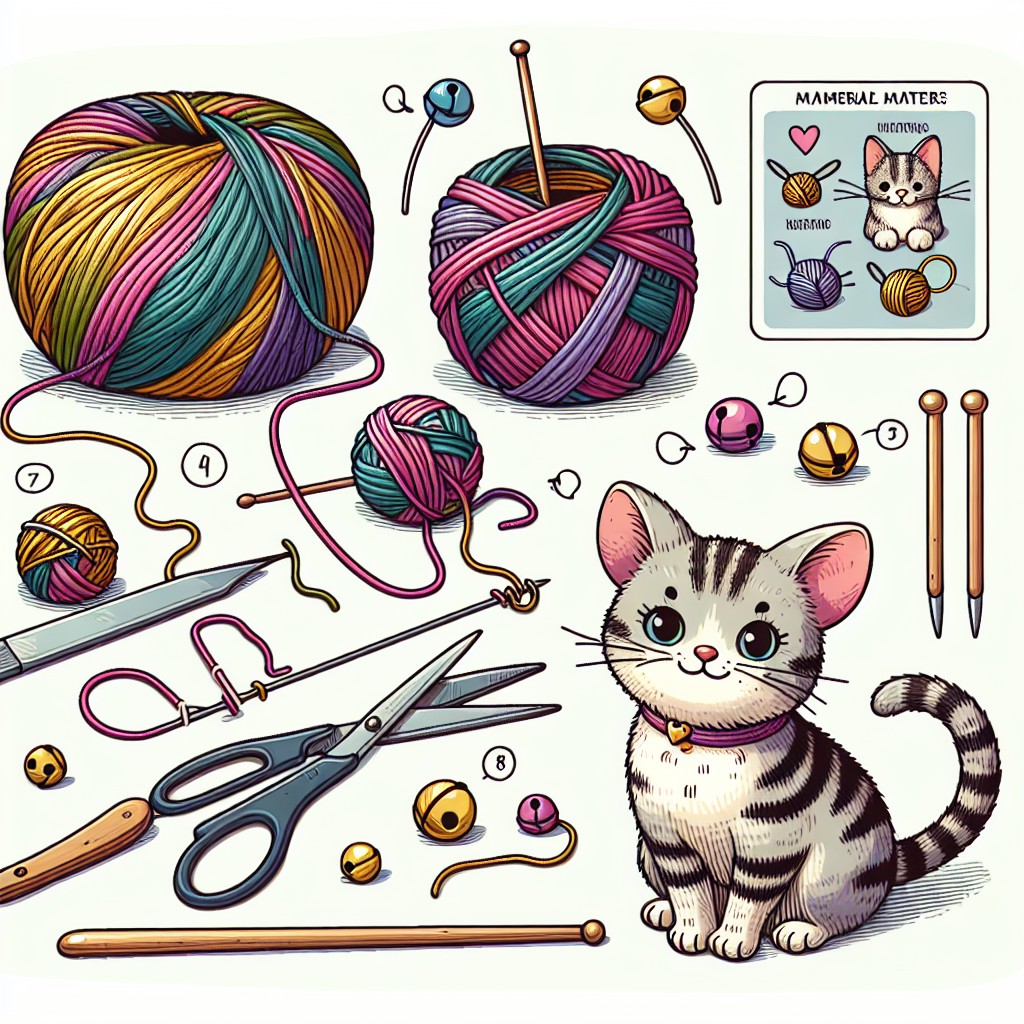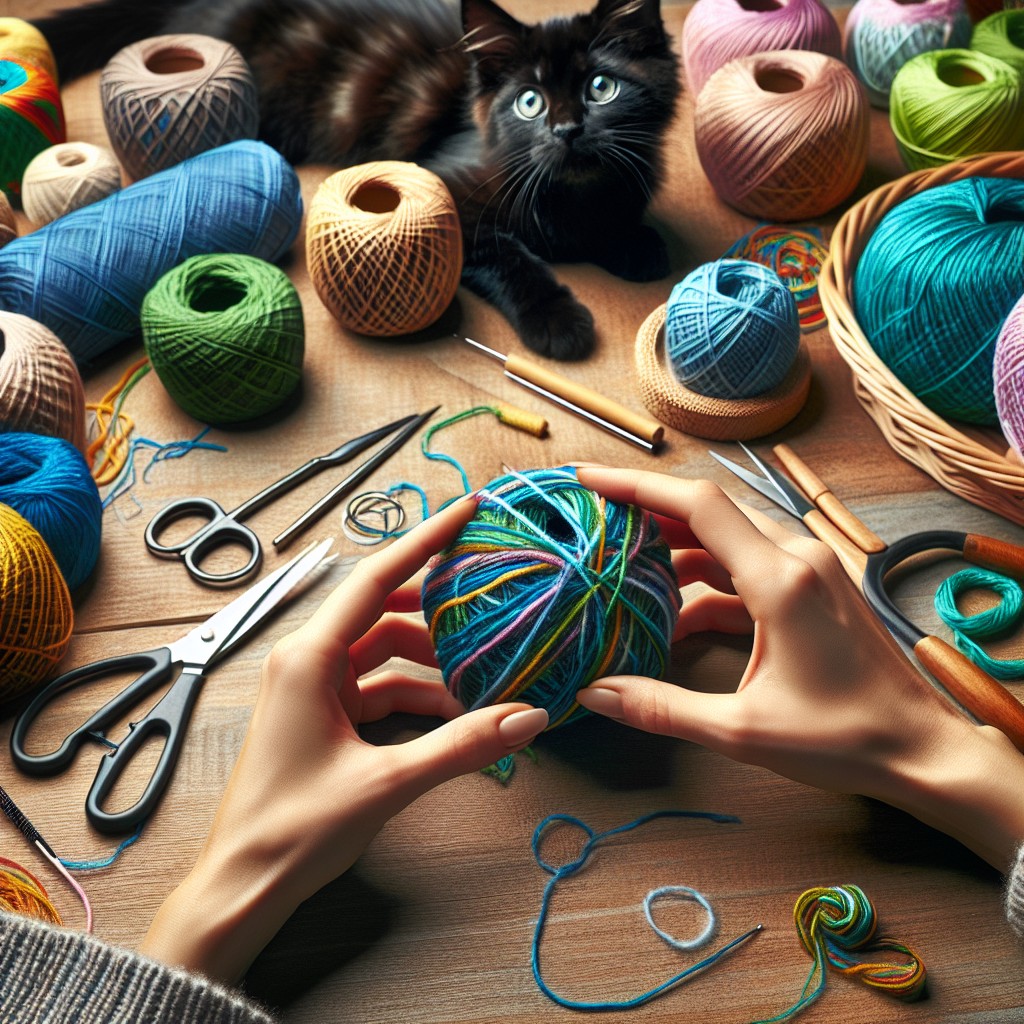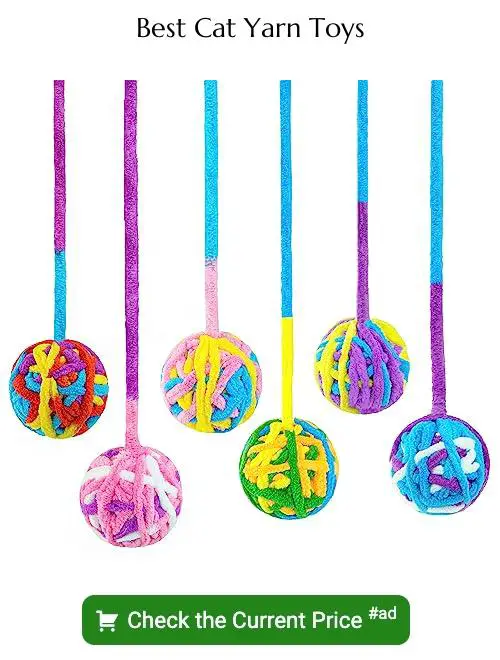Because cats adore playful interaction as much as they love their owners, you can understand how to create irresistible yarn-based cat toys in this article.
Creating cat toys out of yarn is a fun, creative, and cost-effective way to keep your feline friend entertained.
This article will guide you through the process of making your own yarn cat toys, from the materials you’ll need to the step-by-step instructions.
Whether you’re a novice or experienced in yarn crafts, you’ll find these projects enjoyable and easy to follow.
Stay tuned to learn about different toy designs, safety considerations, and even some tips to make your handmade toys more appealing to your cat.
With this comprehensive guide, you’ll be able to create a variety of yarn toys that your cat will love.
Key takeaways:
- Choose natural fibers for safe and durable cat toys.
- Ensure toys are safe by avoiding small objects and secure knots.
- Essential tools include yarn, scissors, hooks/needles, stuffing, thread/needle, and a pattern.
- Follow simple steps to create a yarn ball toy or a yarn mouse toy.
- Add interactive elements like bells, feathers, or catnip for extra appeal.
Selecting the Right Type of Yarn for Cat Toys

When choosing yarn for crafting cat toys, safety is paramount. Opt for natural fibers like cotton or wool, which are durable and less likely to fray or break off into small pieces. Synthetic yarns such as acrylic might cause digestion issues if accidentally ingested. Avoid yarn with metallic threads as they can be harmful to a cat’s sensitive paws and mouth.
Additionally, the yarn should be washable for easy cleaning, and the colorfast to prevent the dye from staining your pet’s fur or your furniture.
Ensuring Pet Safety When Creating Yarn Cat Toys

So, you’ve chosen the perfect yarn. Now, it’s crucial to consider safety measures. First, avoid using fine, easily breakable yarns that may pose a choking hazard. Opt for thicker, stronger yarn varieties instead.
While assembling toys, ensure knots are tied securely to avoid loose ends. Dangling strings may entice your cat but they can be hazardous if swallowed.
It’s also key to avoid incorporating small objects such as beads or bells that can be easily detached and swallowed. If you want to add a little rattle to your toy, opt for larger, securely attached items.
Objects with shiny surfaces or sharp edges are a definite no-no due to the risk of injury. Stick to soft, pliable yarn and fabrics that can withstand sharp claws and teeth. Also, remember to inspect the toys regularly for signs of wear and tear and replace destroyed toys promptly to prevent accidental ingestion.
Lastly, always supervise your cat when they’re playing with these toys. This means you can intervene if necessary, turning playtime not just into a fun, but also a safe experience.
Listing Essential Tools for Making Cat Toys Out of Yarn

To craft superb yarn toys that your furry friend will love, you’ll need a few basic tools:
- Yarn: Choose from a variety of colors, textures, and thicknesses. Ensure it’s durable yet gentle on your cat’s paws.
- Scissors: A sharp pair of scissors ensures clean cuts and less fraying for the yarn.
- Crochet Hooks or Knitting Needles: Your pick depending upon whether you wish to knit or crochet the toy. If you’re new to this, consider a beginner’s guide to both techniques.
- Stuffing Material: Some toys require a soft interior. You can use fiberfill, scrap yarn, or even a little bell to give the toy a soothing sound.
- Thread and Needle: For sewing parts together, securing the stuffing, or adding details.
- Pattern: A guide to follow that details how to construct your yarn cat toy. Plenty of free patterns are available online tailored to various skill levels.
With these tools in hand, you’ll be well-prepared for your project. Get ready to impress your feline friend with a homemade toy!
Steps to Create a Simple Yarn Ball Toy for Cats

Begin by cutting a long strand of yarn, roughly six feet in length. Remember, the size of the ball will depend upon the length of the yarn. Secure one end, then start winding tightly around several fingers to create a small yarn oval. Remove it from your fingers and continue wrapping in different directions to form a sphere. Once you’ve run out of yarn, tuck the loose end into the body of the ball to prevent unwinding.
A note: thicker yarn will result in a larger, chunkier toy, whereas finer yarn will create a smaller one. Also, using multicolored yarn can result in a visually stimulating toy for your feline friend.
To make the toy more appealing, consider incorporating catnip. Carefully sprinkle some dried catnip onto the yarn as you wind it into a ball, making sure it gets caught up in the strands. This will make your cat’s new toy irresistible.
Next, ensure the toy’s durability. To do so, apply a small amount of pet-safe glue to secure the end of the yarn into the ball. This prevents your cat from easily unravelling the ball during play.
Finally, always supervise your cat during play to ensure they do not swallow any loose strands of yarn. If a yarn begins to unravel or fall off, remove it immediately.
Designing a Yarn Mouse Toy for Cats
Start by gathering gray, brown, or white yarn, a pair of scissors, a darning needle, and stuffing material, which can be either more yarn or cotton stuffing.
Begin to create the body of the mouse by crocheting or knitting an oval shape, you may use any stitch you prefer. Make sure it is large enough to attract your cat’s attention but also small enough for the cat to play with it comfortably.
Next, fashion the ears by making two small triangles with the same yarn. Attach these to the top of the oval body with the darning needle.
For a tail, cut a longer piece of yarn, about twice the length of the body, and attach it to the rear of the oval shape.
To give the mouse a realistic look, consider embroidering eyes and a nose onto one end of the body, using black or pink yarn.
Once all elements are attached, stuff the mouse with your chosen stuffing material through a small hole left in the body, then sew the hole up.
Remember, proportions can be adjusted according to preference or the size of your cat. Every mouse will turn out unique, making it all the more special for your pet.
Adding some catnip inside the mouse toy can provide additional stimulation for your feline friend. However, it is crucial to sew it in well to prevent your cat from reaching the catnip, which could potentially pose a choking hazard.
Adding Interactive Elements to Yarn Cat Toys
Incorporating interactive elements not only adds to the appeal of the toy but also stimulates the cat’s predatory instincts.
Consider adding bells or feathers, which would arouse your feline’s sense of sound and sight.
Insert rattling beads inside the yarn ball to engage their sense of hearing.
You can also incorporate catnip, known to be irresistible for most cats, into the yarn toys.
This can be easily done by wrapping the yarn around a small sachet of catnip.
Always ensure these additions are secure to prevent any potential hazards.
Maintenance and Care for Yarn-based Cat Toys
To ensure longevity, it’s vital to inspect your yarn toys frequently for signs of fraying or coming apart. Snip any loose ends promptly to prevent your cat from ingesting loose threads.
For cleaning, gently handwash these toys in warm soapy water, taking care not to distort their shape. Rinse them thoroughly, squeeze out the excess water, and allow them to air dry.
Keep in mind, these toys are not indestructible – replace them when they show significant wear and tear as a safety precaution. Also, fair practice would be to put away these yarn toys when you are not around to supervise playtime.
FAQ
What kind of yarn is safe for cat toys?
The types of yarn considered safe for cat toys are acrylic and cotton.
How do you make kitten toys out of yarn?
To create kitten toys from yarn, simply wrap yarn around three of your fingers, secure it in the middle with another piece of yarn, then cut the loops and fluff them up to form pom-poms.
Is yarn safe for cats to play with?
While cats may enjoy playing with yarn, it is not safe due to the risk of swallowing and developing serious intestinal complications.
What are the best patterns for knitting or crocheting cat toys?
The best patterns for knitting or crocheting cat toys include small balls, stuffed mice, pom pom toys, and catnip-filled sardines, allowing a range of options for varying experience levels.
How can you incorporate catnip into a yarn-made cat toy?
To incorporate catnip into a yarn-made cat toy, stuff a small pouch with catnip and seal tightly before knitting or crocheting the toy around it.
What can you do to make sure the yarn cat toy is durable?
To ensure the yarn cat toy is durable, use high-quality, thick yarn and tie knots securely during crafting.





